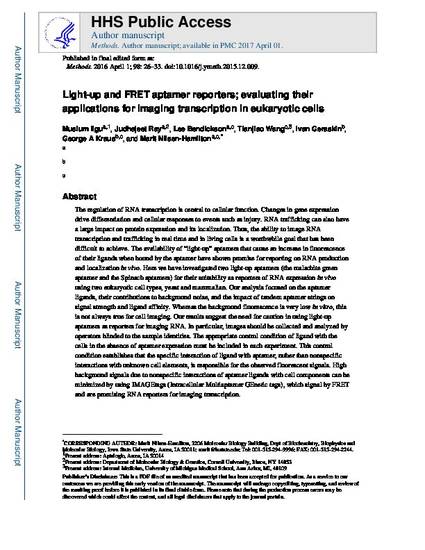
The regulation of RNA transcription is central to cellular function. Changes in gene expression drive differentiation and cellular responses to events such as injury. RNA trafficking can also have a large impact on protein expression and its localization. Thus, the ability to image RNA transcription and trafficking in real time and in living cells is a worthwhile goal that has been difficult to achieve. The availability of “light-up” aptamers that cause an increase in fluorescence of their ligands when bound by the aptamer have shown promise for reporting on RNA production and localization in vivo. Here we have investigated two light-up aptamers (the malachite green aptamer and the Spinach aptamers) for their suitabilities as reporters of RNA expression in vivo using two eukaryotic cell types, yeast and mammalian. Our analysis focused on the aptamer ligands, their contributions to background noise, and the impact of tandem aptamer strings on signal strength and ligand affinity. Whereas the background fluorescence is very low in vitro, this is not always true for cell imaging. Our results suggest the need for caution in using light-up aptamers as reporters for imaging RNA. In particular, images should be collected and analyzed by operators blinded to the sample identities. The appropriate control condition of ligand with the cells in the absence of aptamer expression must be included in each experiment. This control condition establishes that the specific interaction of ligand with aptamer, rather than nonspecific interactions with unknown cell elements, is responsible for the observed fluorescent signals. High background signals due to nonspecific interactions of aptamer ligands with cell components can be minimized by using IMAGEtags (Intracellular Multiaptamer GEnetic tags), which signal by FRET and are promising RNA reporters for imaging transcription.
Available at: http://works.bepress.com/marit-nilsen-hamilton/31/

This is an article from Ilgu, Muslum, Judhajeet Ray, Lee Bendickson, Tianjiao Wang, Ivan M. Geraskin, George A. Kraus, and Marit Nilsen-Hamilton. "Light-up and FRET aptamer reporters; evaluating their applications for imaging transcription in eukaryotic cells." Methods 98 (2016): 26-33. DOI: 10.1016/j.ymeth.2015.12.009. Posted with permission.